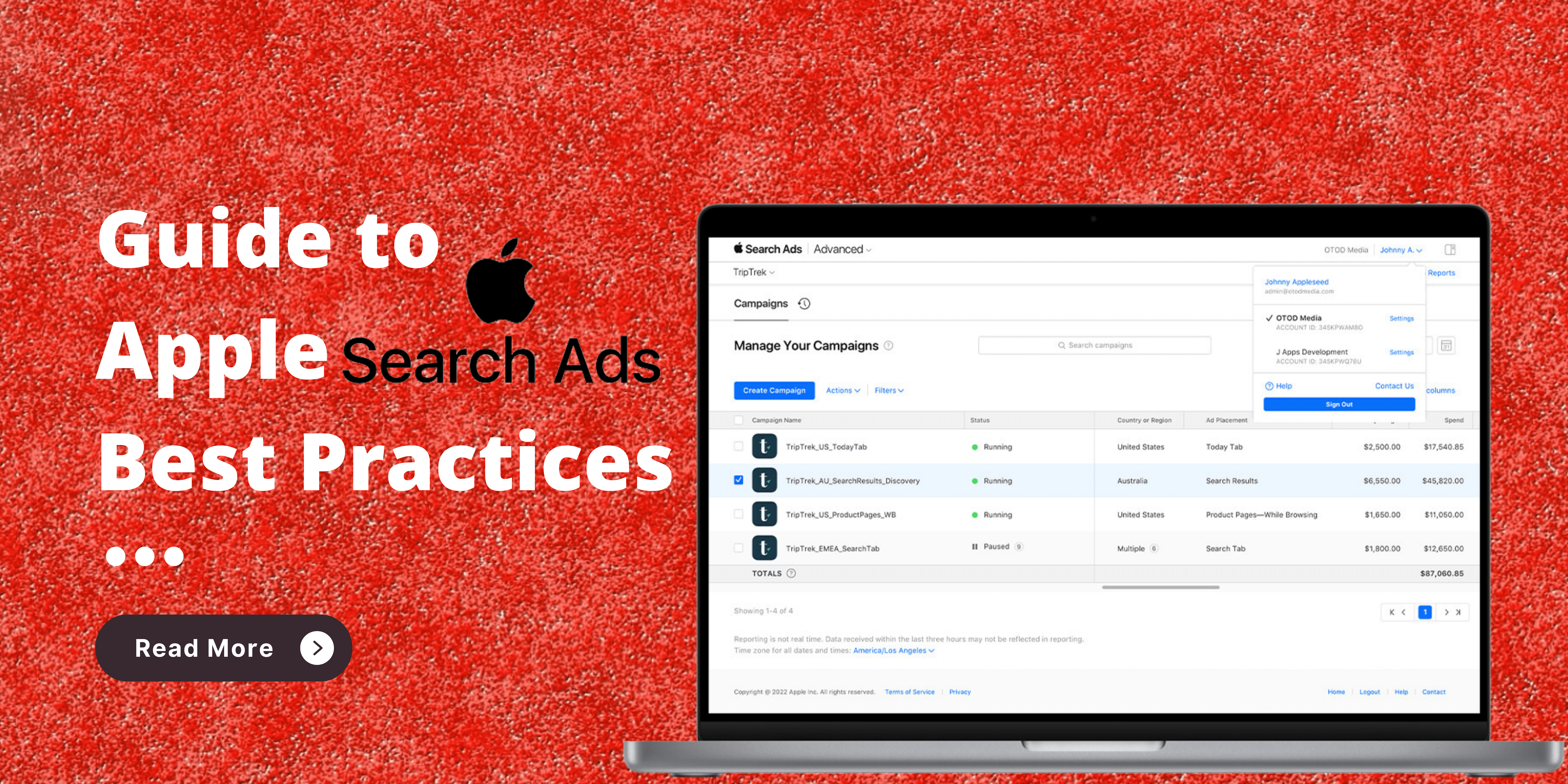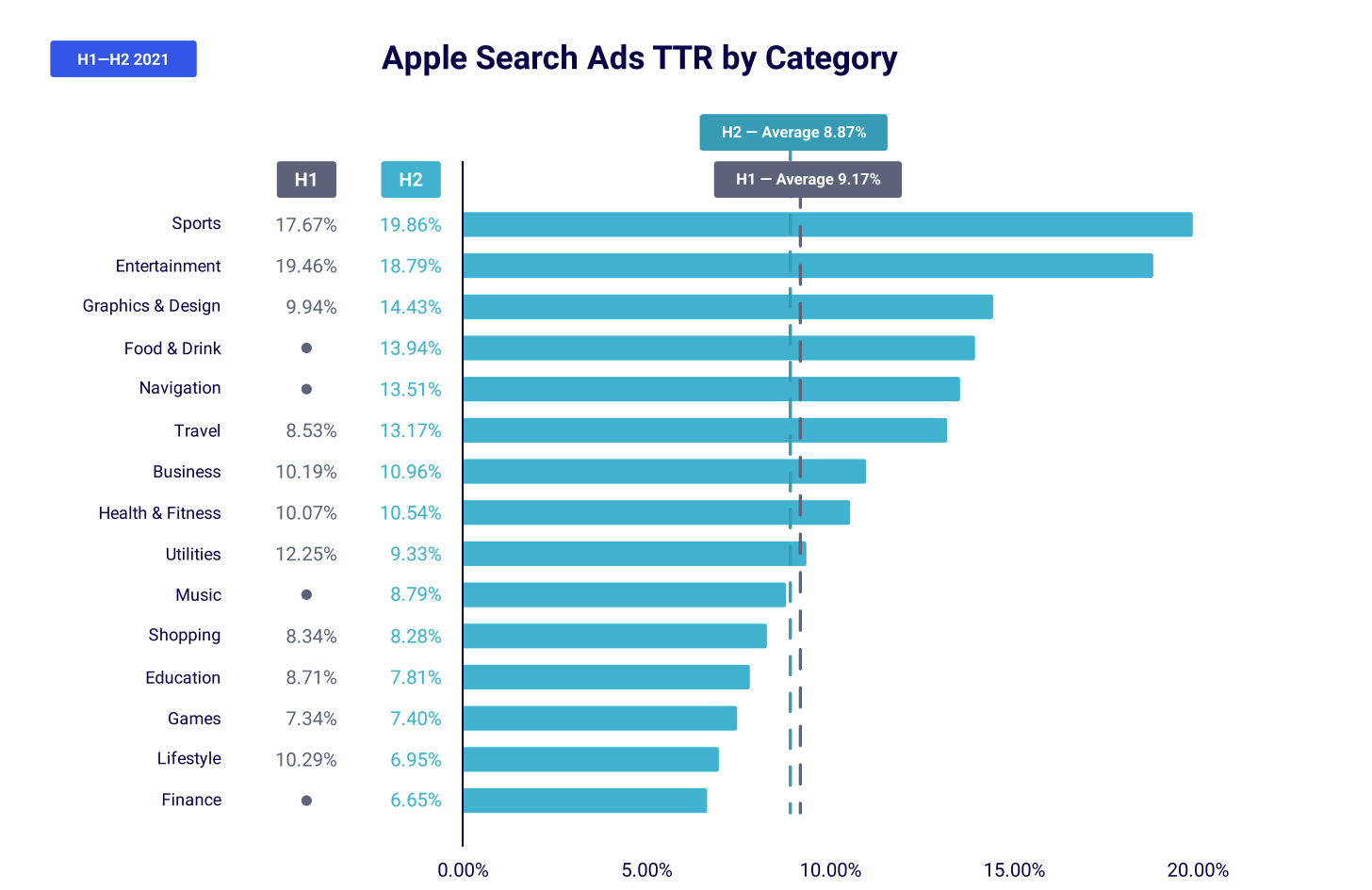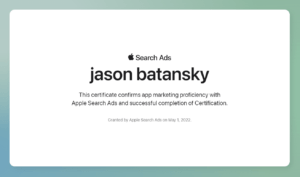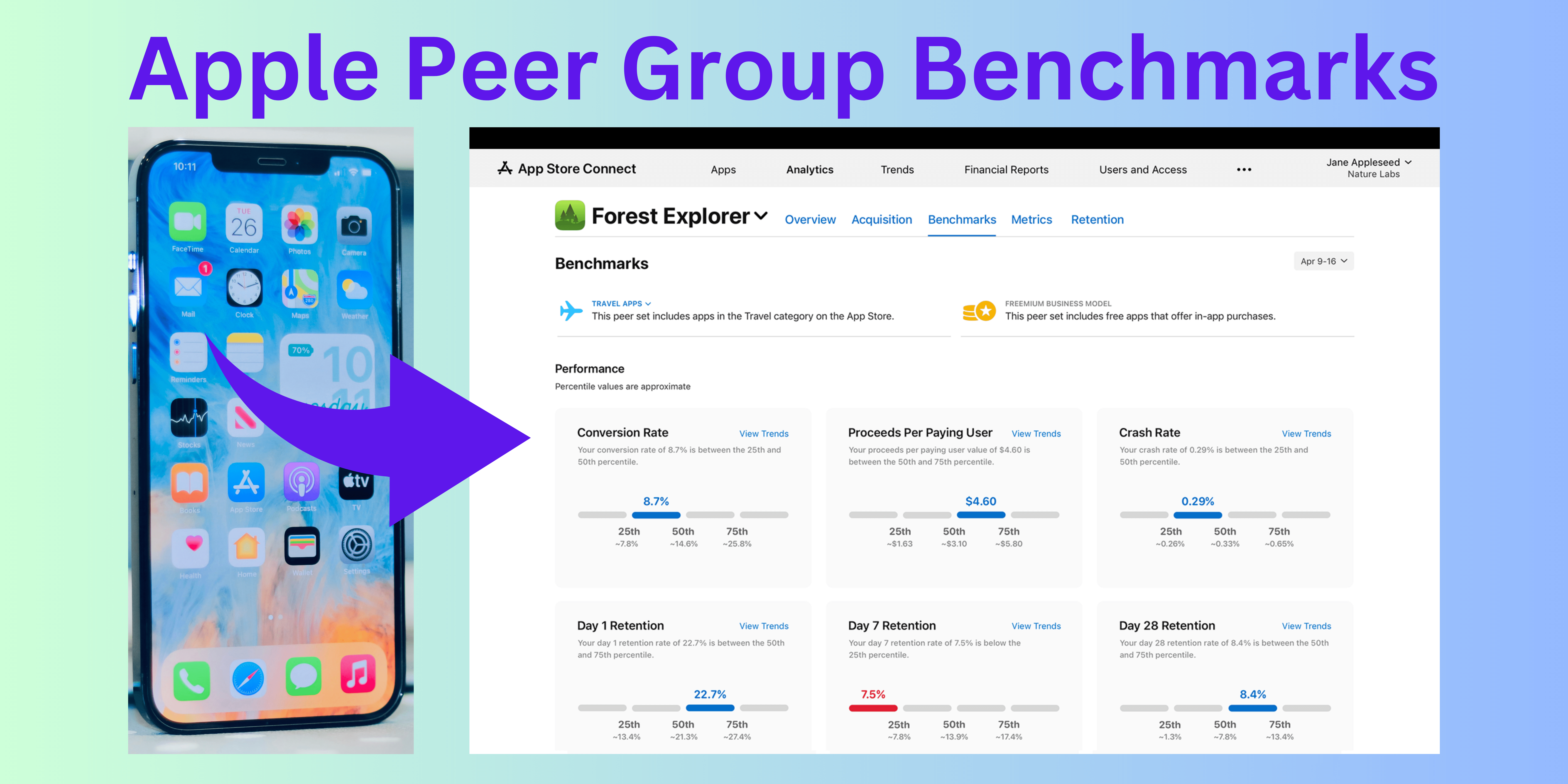- Электронная почта:[email protected]
- телефон:+1 (305) 340-3049
26 Мар

Apple Search Ads Best Practices
Apple Search Ads is an advertising platform that enables app developers and marketers to promote their mobile applications within the Apple App Store. Поисковая реклама Apple operates on a pay-per-click (PPC) model, where advertisers bid on keywords that are relevant to their app, and then their ads are displayed when users search for those keywords within the App Store. With millions of apps available on the App Store, it is essential for app developers to utilize the best practices to make their app stand out in search results.
One way to achieve this is by promoting your app through Apple Search Ads, which offers several advantages over other advertising channels.
High Conversion Rates
According to Apple, developers using Search Ads enjoy an average conversion rate of 50%, which is impressive compared to other advertising platforms. This means that half of the users who click on your ad are likely to download your app. As a result, Search Ads are an effective way to acquire high-quality users who are more likely to engage with your app and become loyal customers.
Increased Visibility
Approximately 65% of app installs on the App Store come from search queries, making it the most common way for users to discover new apps. By running campaigns in Search Ads, your app appears at the top of relevant search results, giving it more visibility and increasing the likelihood of downloads.
Quality User Acquisition
Users who tap on a featured app through Search Ads behave like organic users, rather than seeing it as an ad banner. This leads to a higher rate of engagement and retention, as users are more likely to engage with your app’s content and features. Therefore, Search Ads can help you acquire quality users who are genuinely interested in your app and more likely to become loyal customers.
Targeted Advertising
Apple Search Ads allows you to target different customer types, including first-time downloaders, users who have already downloaded your app, and those who use other products you’ve developed. This flexibility allows you to tailor your advertising campaigns to specific user groups and achieve your marketing objectives.
Lower Acquisition Cost
Compared to other advertising platforms, Apple Search Ads boasts a 40% lower acquisition cost. With a cost-per-tap (CPT) model, you only pay for users who are interested and high-converting. This ensures that your advertising budget is spent effectively and efficiently, resulting in a higher return on investment (ROI).
Here are some best practices to help you optimize your Apple Search Ads campaigns:
Understand your target audience
Before creating your Apple Search Ads campaigns, it is essential to understand your target audience. Identify your app’s ideal users, their demographics, interests, and behavior. This information will help you choose the right keywords, create effective ad copy, and target the right users.
Check if your ASA campaign is sustainable
Several key metrics are used to measure the performance of Apple Search Ads campaigns, including CPA, TTR, and CR.
CPA, or Cost Per Acquisition, is a benchmark that measures the cost of acquiring a new user who installs and opens the app after clicking on an Apple Search Ad. The lower the CPA, the better the campaign’s performance, as it indicates that the advertiser can acquire new users at a lower cost. The industry standard for CPA in Apple Search Ads is around $2-$3, but it can vary depending on the app category and the competition in the market.
TTR, or Tap Through Rate, is a benchmark that measures the number of users who click on an Apple Search Ad out of the total number of impressions served. The higher the TTR, the better the performance of the campaign, as it indicates that the ad is relevant and engaging to the target audience. The industry standard for TTR in Apple Search Ads is around 10%-15%, but it can vary depending on the ad creatives, targeting, and bidding strategy.
CR, or Conversion Rate, is a benchmark that measures the percentage of users who install and open the app after clicking on an Apple Search Ad. The higher the CR, the better the performance of the campaign, as it indicates that the ad is effectively targeting the right audience and driving user acquisition. The industry standard for CR in Apple Search Ads is around 20%-30%, but it can vary depending on the app category, user behavior, and competition in the market.
It is important to note that these benchmarks are not fixed and can vary depending on several factors, such as the app category, the targeting strategy, the ad creatives, and the competition in the market. Therefore, it is important to regularly monitor and optimize Apple Search Ads campaigns to achieve the best possible performance and meet the specific goals of the advertiser.
Set up your campaign structure
Having a well-organized account structure is crucial to the success of your Apple Search Ads campaigns. Apple recommends a structure that combines four elements for better reporting and bids management.
- Brand: Keywords that include your app and company name can capture high-intent users who are specifically searching for your brand.
- Generic/Non-brand: Keywords based on themes and descriptive terms for your app can help reach new users and raise your brand awareness.
- Competitors: Using keywords relevant to major competitors can be a great way to attract new users who are looking for similar apps.
- Discovery: Discovery campaigns are used for finding new, relevant keywords by using broad keywords and Search Match.
There are several reasons why you need to build a proper account structure.
Firstly, a proper account structure ensures that your ad groups are profitable. By grouping your keywords and ads by themes or categories, you can better target your audience and increase the relevance of your ads. This can lead to higher click-through rates (CTR), lower cost-per-click (CPC), and, ultimately, higher return on investment (ROI).
Secondly, a proper account structure helps you spread keywords in a reasonable way. By dividing your campaigns into ad groups, you can allocate your budget and bids more efficiently based on the performance of each group. This way, you can focus on the high-performing groups and adjust the bids and budgets of the underperforming ones.
Lastly, having a proper account structure enables you to optimize your spend and scale your campaigns. With a clear structure, you can easily track the performance of your campaigns and make data-driven decisions to improve them. You can also test different strategies and see how they impact your performance.
Choose the right keywords
ASO keyword research is one of the most critical aspects of a successful Apple Search Ads campaign. When users search for apps in the App Store, they use specific keywords describing what they seek. Therefore, it is essential to do thorough keyword research to find the most relevant and high-traffic keywords for your app.
One way to conduct ASO keyword research is to use ASO tools like Mobile Action, AppRadar, and AppTweak. These tools can help you find keywords that are relevant to your app and have high search traffic. By using these tools, you can get insights into your competitors’ keyword strategies, analyze keyword trends, and identify new opportunities.
It’s also essential to choose a mix of broad, phrase, and exact-match keywords. Broad match keywords allow your ad to appear in a wider range of search queries, while phrase and exact match keywords provide more precise targeting. Including a mix of these types of keywords can help you reach a broader audience while ensuring that your ads are shown to users who are more likely to be interested in your app.
To ensure the success of your Apple Search Ads campaign, it’s essential to monitor your keyword performance regularly. Keep track of which keywords drive the most clicks and conversions and which are underperforming. Use this data to optimize your bids and keywords, focusing on the keywords that are driving the most value for your app.
Write compelling screenshot text captions
In the crowded app store, your app screenshots are often the first impression users will have of your app. That’s why it’s essential to make sure your screenshot text captions are compelling and effective. Keep in mind that users typically scan through the captions quickly, so they should be concise and to the point.
Use your captions to highlight your app’s unique features and benefits, and include a clear call-to-action. Make sure your captions align with your app’s messaging and branding, and avoid using vague or generic language. Instead, use descriptive and action-oriented language that will appeal to your target audience.
Optimize your App Store listing
One of the benefits of ASO is that it can also improve the performance of your Apple Search Ads campaigns. The Apple Search Ads algorithm uses various signals, including the relevance and quality of your app’s listing, to determine when and where to serve your ads.
By optimizing your app’s listing for ASO, you can improve the relevance and quality of your app, making it more likely to appear in relevant search results and receive more clicks and downloads. This, in turn, can improve the performance of your Apple Search Ads campaigns, as the algorithm will serve your ads to users who are more likely to be interested in your app.
To optimize your app for ASO, start by conducting keyword research and selecting the most relevant and high-traffic keywords to include in your app’s metadata. Use these keywords strategically in your app’s title, subtitle, and description to make it clear to users and the algorithm what your app is about.
Also, pay attention to your app’s visuals, including the app icon, screenshots, and videos. Use high-quality visuals that accurately showcase your app’s features and benefits and align with your app’s branding.
Regularly monitor and update your app’s listing to stay on top of search trends and user behavior changes. Test and experiment with different elements of your listing, such as the title, description, and visuals, to see what works best for your app and its audience.
Design Custom Product Pages
Custom product pages are an important tool for optimizing your Apple Search Ads campaigns. By creating variations of your product pages, you can target different audiences with more relevant content, which can result in higher conversion rates and a better return on your advertising investment. In this post, we’ll explore the practical value of custom product pages and how to test them for maximum effectiveness.
Why Use Custom Product Pages?
Custom product pages offer several advantages for your Apple Search Ads campaigns. First and foremost, they allow you to showcase your brand and highlight your unique selling proposition (USP). You can create more engaging ads that resonate with your target audience by featuring specific features, services, or messages.
For example, you can use custom product pages to optimize your ads for specific markets, taking into account the mentality and cultural differences of different regions. Adjusting your App Store product page to highlight a specific feature or content for a specific country or region can increase your chances of success in that market.
Custom product pages also allow you to test different value propositions based on audience interests and your hypothesis. For instance, you can use custom product pages for purchase optimization to determine which specific theme and custom product page bring you more conversions for a better price.
To get the most out of your custom product pages, testing them for maximum effectiveness is important. Here are some tips for testing custom product pages:
- Create different variations of your product pages based on audience interests, market differences, and holidays/promos.
- Test different value propositions for each custom product page variation.
- Use ad variations based on custom product pages to engage your audience with more relevant content.
- Adjust your App Store product page to highlight a feature or particular content to a specific country or region.
- Create winter or summer campaigns, change images for specific holidays, make promo offers for Black Friday or Cyber Monday, and more.
- Test different themes with ad variations based on custom product pages for each ad group.
- Retarget your campaigns to your past customers to highlight new features or remind them about your app.
Use targeting options effectively
One of the critical factors in the success of your Apple Search Ads campaigns is reaching the right audience. Apple Search Ads offers several targeting options to help you target the audience that is most likely to download and use your app.
The first targeting option is location targeting. This option allows you to target users based on their geographic location. You can choose to target users in a specific country, region, city, or even a specific radius around a location. This targeting option is particularly useful for apps that offer location-specific services or have a local focus.
Device targeting is another effective targeting option. You can choose to target users based on the type of device they are using, such as an iPhone or iPad. This targeting option is useful for apps optimized for a particular device type or with different user interfaces on different devices.
Language targeting is also available on Apple Search Ads. You can target users based on the language they use on their devices. This targeting option is particularly useful for apps that offer language-specific services or have a global user base.
Operating system (OS) version targeting is another targeting option available on Apple Search Ads. You can target users based on their operating system version, such as iOS 14 or iOS 15. This targeting option is useful for apps that require a specific operating system version to run or have different features on different operating system versions.
Lastly, audience targeting is a powerful targeting option on Apple Search Ads. You can target users based on their past app usage behavior, such as users who have installed similar apps or made in-app purchases. This targeting option allows you to reach users who are more likely to download and use your app.
To use these targeting options effectively, it’s important to identify your target audience and understand their demographics, interests, and behavior. This information lets you choose the right targeting options to reach your audience effectively. Monitoring your campaigns regularly and optimizing your targeting options based on their performance is also important. By using targeting options effectively, you can improve the ROI of your Apple Search Ads campaigns and reach the right audience with the right message.
Test and optimize your campaigns
Testing and optimization are critical to the success of your Apple Search Ads campaigns. Continuously monitoring and analyzing your campaigns can provide insights that will help you make better decisions in the future.
To optimize your campaigns, you should regularly review your performance data and identify the keywords, ad copy, and targeting options that are performing well. You can use this data to make adjustments and optimize your campaigns to improve your return on investment (ROI).
One effective strategy is to test different ad variations and keywords to see which ones perform the best. You can test different ad copy, visuals, and targeting options to see which ones drive the most clicks and conversions.
Another key aspect of testing and optimization is analyzing your conversion rates. Are users who click on your ads actually downloading your app? If not, you may need to adjust your targeting, ad copy, or landing page to improve conversion rates.
Monitoring your spending and adjusting your bids based on performance data is also essential. By monitoring your budget and bidding strategy regularly, you can ensure that you are not overspending and that you are bidding competitively.
Monitor your budget and bidding strategy
Apple Search Ads operates on a PPC model, which means that you only pay when a user clicks on your ad. Monitor your budget and bidding strategy regularly to ensure that you are not overspending. Optimize your bids based on the keyword performance to ensure that you are bidding competitively.
Use ad groups
Using ad groups is an effective way to organize your Apple Search Ads campaigns and improve their performance. Ad groups are collections of keywords and ads that are grouped together based on a specific theme or category. By organizing your campaigns into ad groups, you can:
- Improve relevance: Ad groups help ensure that your ads are relevant to the user’s search query. By grouping together related keywords and ads, you can create more targeted campaigns that are more likely to convert.
- Monitor performance: Ad groups help you monitor the performance of your keywords and ads more easily. By grouping keywords and ads based on their performance, you can identify which ad groups are performing well and which ones need improvement.
- Optimize bids: Ad groups allow you to set different bids for each group. This allows you to optimize your bids based on the performance data, ensuring that you are bidding competitively for each keyword.
When creating ad groups, choosing a specific theme or category relevant to your app and its features is important. For example, if you have a fitness app, you could create ad groups based on different types of workouts, such as “yoga,” “cardio,” and “strength training.” Within each ad group, you can include relevant keywords and ads targeting users searching for those specific types of workouts.
By using ad groups, you can improve the relevance of your ads, monitor their performance more easily, and optimize your bids to improve your ROI.
Analyze your competition
Analyze your competitors’ Apple Search Ads campaigns to gain insights into their strategies and identify opportunities for improvement. Review their ad copy, keywords, targeting options, and landing pages to understand their approach. Use this information to optimize your campaigns and stand out from the competition.
Utilize A/B testing
A/B testing, also known as split testing, is a technique that allows you to test two variations of an ad or landing page to determine which performs better. Use A/B testing to test different ad copy, images, and landing pages to identify what resonates best with your target audience. This can help you improve your campaign’s performance and drive more app downloads.
Keep up with industry trends
Stay up-to-date with the latest industry trends and Apple Search Ads changes to ensure your campaigns remain relevant and effective. Attend industry conferences and webinars, read industry publications and blogs, and network with other app developers and marketers. This can help you stay ahead of the competition and improve your campaign’s performance.
By incorporating these additional best practices into your Apple Search Ads campaigns, you can further improve your campaign’s performance and drive more app downloads. Remember to regularly monitor your campaigns, test and optimize your ads, and stay up-to-date with industry trends to ensure ongoing success.
Final thoughts on Apple Search Ads
Apple Search Ads is an excellent platform for app developers and marketers to promote their apps on the App Store. With millions of apps available, utilizing the best practices to make your app stand out in search results is essential. Understanding your target audience, choosing the right keywords, writing compelling screenshot text captions, optimizing your App Store listing, and using targeting options effectively are all critical components of a successful Apple Search Ads campaign.
Following these best practices can improve your app’s visibility, increase downloads, and achieve your marketing goals. Remember to monitor and optimize your campaigns regularly to stay ahead of search trends and user behavior changes.
Need Help With Apple Search Ads (ASA)?
Consider hiring Outrank Apps to set up and manage your ASA campaign. Outrank Apps will work with you to identify the best keywords and ad placements for your target audience and continuously optimize your campaign to ensure its success. With Outrank Apps, you can be confident that your ASA campaign is in good hands, allowing you to focus on other important aspects of your business. See the Apple Search Ads certification.







Джейсон Батански